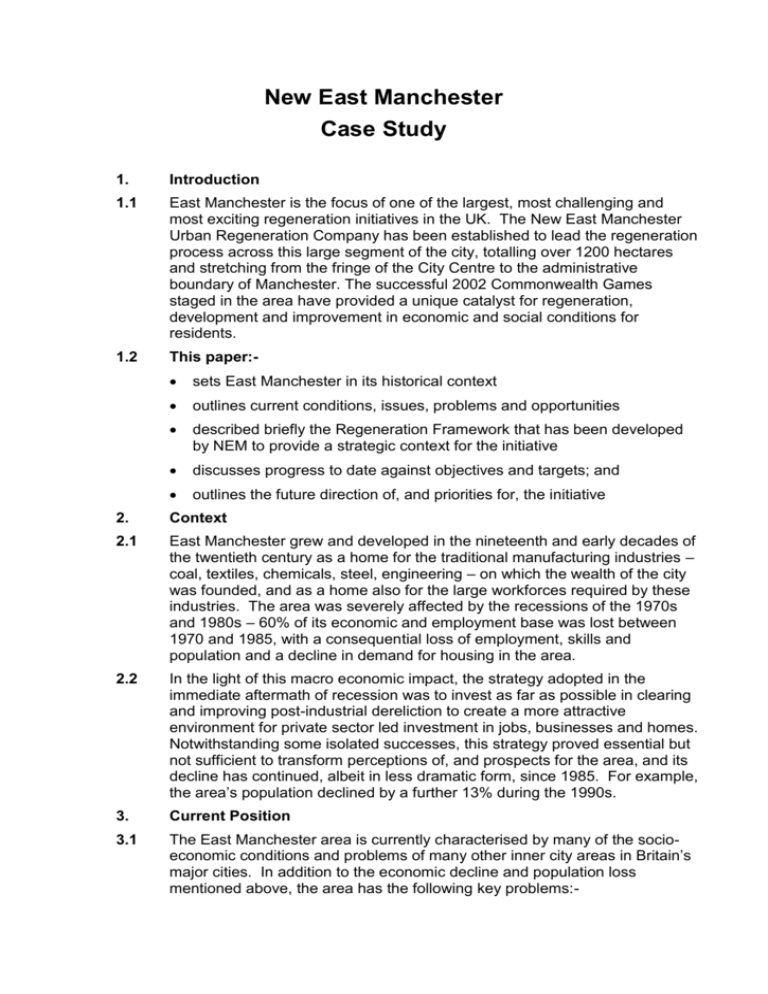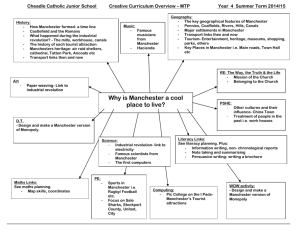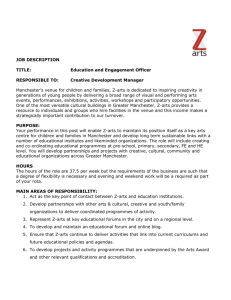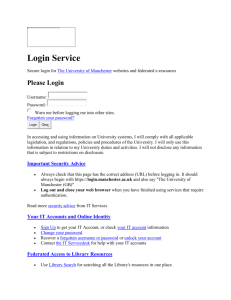New East Manchester Case Study
advertisement

New East Manchester Case Study 1. Introduction 1.1 East Manchester is the focus of one of the largest, most challenging and most exciting regeneration initiatives in the UK. The New East Manchester Urban Regeneration Company has been established to lead the regeneration process across this large segment of the city, totalling over 1200 hectares and stretching from the fringe of the City Centre to the administrative boundary of Manchester. The successful 2002 Commonwealth Games staged in the area have provided a unique catalyst for regeneration, development and improvement in economic and social conditions for residents. 1.2 This paper: sets East Manchester in its historical context outlines current conditions, issues, problems and opportunities described briefly the Regeneration Framework that has been developed by NEM to provide a strategic context for the initiative discusses progress to date against objectives and targets; and outlines the future direction of, and priorities for, the initiative 2. Context 2.1 East Manchester grew and developed in the nineteenth and early decades of the twentieth century as a home for the traditional manufacturing industries – coal, textiles, chemicals, steel, engineering – on which the wealth of the city was founded, and as a home also for the large workforces required by these industries. The area was severely affected by the recessions of the 1970s and 1980s – 60% of its economic and employment base was lost between 1970 and 1985, with a consequential loss of employment, skills and population and a decline in demand for housing in the area. 2.2 In the light of this macro economic impact, the strategy adopted in the immediate aftermath of recession was to invest as far as possible in clearing and improving post-industrial dereliction to create a more attractive environment for private sector led investment in jobs, businesses and homes. Notwithstanding some isolated successes, this strategy proved essential but not sufficient to transform perceptions of, and prospects for the area, and its decline has continued, albeit in less dramatic form, since 1985. For example, the area’s population declined by a further 13% during the 1990s. 3. Current Position 3.1 The East Manchester area is currently characterised by many of the socioeconomic conditions and problems of many other inner city areas in Britain’s major cities. In addition to the economic decline and population loss mentioned above, the area has the following key problems:- 3.2 a collapse in the housing market during the 1990s, particularly for older, smaller pre-1919 terraced property. The current imbalance between supply and demand has seen prices for this form of housing drop to below £5000 in parts of the area, leaving many owner occupiers in severe negative equity and a high proportion of void property. Coupled with this, there is a lack of quality and choice in the market for private housing in East Manchester, further exacerbating population loss local authority housing, representing just under 50% of the housing stock in the area, whilst suffers from relatively stable, very low demand and is in need of major investment in modernisation and improvement. decline in values has seen significant numbers of properties shift from owner occupation to private-rented accommodation which is currently unregulated. The activities of some absentee private landlords – particularly the poor quality of management of their stock or their tenants – has put further pressure on social conditions and effectively destabilised local communities in parts of East Manchester a low skills base within the local working age population. The shift in the City’s economy from traditional manufacturing, requiring large number of skills and semi-skilled workers, to a higher value added and service sector economy, has severely restricted employment prospects for many residents and has placed a premium on retraining and upskilling. high crime rates, with burglary, juvenile nuisance and domestic violence all substantially above the city average. poor health with the incidence of lung cancer almost three times the UK average, and heart and circulatory diseases more than twice the national average. high levels of unemployment and benefit dependency. Unemployment, measured in terms of benefit claimants, is around 10%. “Worklessness”, taking into account those in the working age population who are not actively seeking work or claiming benefit, is much higher at over 20%. 52% of households are in receipt of state benefits in some form. poor quality infrastructure and environment. Notwithstanding the investment over two decades in environmental improvement, East Manchester still has a disproportionate amount of ex-industrial land requiring clearance, remediation and improvement, in addition, and particularly in the older, more historic parts of the area developed around its canals, mills and warehouses, a nineteenth-century infrastructure needs modernisation and upgrading to be fit for purpose in the 21st century, as do transport connections, particularly public transport. These problems cannot be claimed to be unique to East Manchester, but are replicated in most of Britain’s cities that developed as a result of the industrial revolution. However, the scale and intensity of deprivation – across an area several times the size of the city centre and with a resident population of over 30,000 - does distinguish East Manchester from many other areas of urban deprivation. 3.3 Alongside the problems outlined above, a number of opportunities have emerged over the last five years which collectively have created the conditions and generated the momentum for a comprehensive and sustainable regeneration of East Manchester. In particular: the legacy of the Commonwealth Games – the investment of over £100 million into the development of world-class sports facilities in the heart of the area, the thousands of jobs generated as a consequence, the millions of visitors to the area in perpetuity, and the fundamental shift in image and perception of the area, have had a catalytic effect on the prospects for the economic and social improvement of East Manchester the economic buoyancy and success of the City Centre of Manchester has generated development pressures which can be extended into the east of the city the heritage of the area – in terms of its canals, historic buildings and open spaces – is a positive force for regeneration and provides a unique and distinctive character and ‘sense of place’ on which future development and growth can be built completion of the final East Manchester section of the M60 orbital motorway, and Government’s more recent decision to support the construction of future phases of the Metrolink LRT system (two of whose lines will serve East Manchester) will radically improve the connectivity of the area to the city centre, universities, Manchester’s international airport and to wider markets Government policy, recognising the importance of cities as the engines of economic growth, and focussing investment and development within urban core areas, has in itself generated a reappraisal of the potential of East Manchester to contribute positively to regional and national economic priorities, and stimulated a sea change in market perceptions of the area. 3.14 The economic decline of East Manchester has generated a range of economic and social problems, which have challenged the very basis of community in many parts of the area. The economic resurgence which the area will undergo in the next decade will be accompanied by a range of measures to secure benefit – particularly employment – for all local people, to enhance the social and economic base of the area by making East Manchester an attractive, accessible and competitive area in which to live and work, and to provide the range and quality of facilities which are necessary to ensure its long-term viability. 4. East Manchester Regeneration Framework 4.1 The East Manchester Regeneration Framework, prepared by NEM, and launched in April 2001, sets out a long-term strategic context for the economic, physical and social improvement of the area. The Framework is consciously holistic in nature, addressing housing, economic development, employment, education, transport, social and environmental issues in an integrated manner. NEM and all the other agencies and initiatives involved in East Manchester recognise that integrated action – tackling these issues together, seeing and addressing the linkages between them – is a precondition of sustainable regeneration. 4.2 It is the sum of these parts, which is important in establishing the vision for East Manchester. Fundamentally the objective is that East Manchester will become once again an area of choice – to live, work, invest – rather than an area of last resort; competitive with other parts of the city and conurbation; and thereby reconnected with, and able to participate in, the economic and social success of Manchester. 4.3 The creation of a dynamic economic base is fundamental to the successful regeneration of the area. The economic base will generate employment for residents and create the wealth necessary for sustained improvement. 4.4 The economic vision for East Manchester encompasses the provision of a range of high quality employment opportunities, which will have a direct impact upon reducing unemployment and economic inactivity amongst the resident population. Whilst it is large enough as an area to accommodate a wide variety of business uses – and, from the point of view of local employment, important that it does – there will be a particular emphasis on attracting businesses and jobs in those sectors of the economy with the strongest potential for future growth – information and communications, advance science and technology, creative and media industries. In spatial terms, employment growth will be focussed on Central Park Manchester, Openshaw Business Centre, the Ashton Canal Corridor and Ancoats Urban Village. 4.5 The regeneration of the area will be built upon ensuring that local people secure direct benefit from major investments through having the skills, motivation and support, which will enable them to access the many opportunities that the developing economy of East Manchester will provide. The need for a skilled and adaptable pool of labour will also be key to the attraction of new employers and new sectors making the matching of labour supply and demand a key component of the strategy. 4.6 As fundamental to the strategic regeneration objectives for the area as business and employment growth is complementary and integrated action to improve the quality of life in neighbourhoods across the area. Residents need to have confidence that individual betterment (through for example, employment), will be matched by community betterment if the cycle of outmigration is to be reversed. The content of the Regeneration Framework – directly addressing key issues for residents, such as education, crime, health and community facilities, alongside spatial and economic planning – reinforces the link between individual and community. Equally, the process by which the Framework was developed, involving very extensive consultation with local residents and stakeholders, was similarly intended to give confidence to local people about prospects for improvement of their community. 4.7 The Regeneration Framework also:- 4.7.1 establishes a set of development and design principles intended to ensure that new development is well-designed, sustainable and appropriate to the area, recognising the crucial importance of good design in regeneration 4.7.2 sets key headline targets for New East Manchester and its partners. These include: doubling the population of East Manchester from 30,000 to 60,000 over a 10-15 year period construction of around 12,500 new homes comprehensive improvement and modernisation of 7000 existing homes development of a 160 hectare new business park – Central Park Manchester – to provide opportunities for new business growth and expansion creation of over 10,000 new jobs in the area completion of the Sportcity complex of world-class sporting facilities in the heart of the area a new commercial and retail centre for East Manchester at Sportcity development of an integrated public transport system incorporating Metrolink, heavy rail, bus and car transport, as well as pedestrian and cycling provision raising educational attainment in East Manchester schools above the city average 5. Progress to Date 5.1 From the point at which Manchester was awarded the 2002 Commonwealth Games in 1995 and was thus actively able to pursue its regeneration strategy for East Manchester, the area has been the focus for a wide range of special Government initiatives – New Deal for Communities, Single Regeneration Budget, Education Action Zone, Sports Action Zone, Sure Start etc., - which have delivered investment targeted largely on improving the social conditions and economic prospects of existing residents. 5.2 New East Manchester – one of the first three designated urban regeneration companies in the country – was formally established in Autumn 1999 as a partnership between Manchester City Council, North West Development Agency, English Partnerships and local communities. Its key roles are to: develop and implement – in partnership with others – the Regeneration Framework for East Manchester lead the major strategic physical regeneration of the area coordinate, integrate and oversee the design and delivery of the range of special initiatives mentioned earlier secure public and private resources (around £2 billion in total) to deliver the comprehensive, long-term programme focus mainstream public services and funding (estimated at £150 million per annum) more effectively on the need and aspirations of local residents and stakeholders 5.3 The imminence of the Commonwealth Games – only 2 ½ years away at the point at which NEM was established – provided a strong impetus for early and concerted action to generate new jobs, businesses and homes in the area, and provided early momentum for what remains a much longer-term initiative. 5.4 Key achievements to date include: completion of the Sportcity complex on budget and in time for last summer’s Commonwealth Games. The current conversion of the City of Manchester stadium into a football stadium will be completed in July 2003 when Manchester City F.C. take up occupation. This use of the stadium, together with community use of the other facilities at Sportcity, has generated thousands of jobs in construction and operation, and millions of visits per annum to East Manchester in perpetuity construction of a new 180,000 sq.ft. Asda-Walmart store (the first and largest purpose-built Walmart store in Europe) prior to the Games as the first phase of the new commercial centre for East Manchester A £24 million investment programme in the Ashton Canal corridor to provide a safe, attractive and accessible pedestrian route from the city centre to Sportcity, and to open up the development potential of key sites and buildings along the route. Three such developments are now at an advanced planning stage, with all three expected to start on site later this year. Phase 1 of Central Park Manchester (92 acres) has been fully assembled (through a Compulsory Purchase Order) and remediated, and a new road system has been constructed to facilitate development. Agreements have been concluded with Fujitsu UK to construct 150,000 sq.ft. of new office space, and work will start on site in April this year. Funding and consents have also been secured for a new transport interchange to serve the business park, and work will start in Autumn 2003 Three major new residential schemes have been developed in conjunction with private sector partners. The first of these started on site last month (Countryside Properties at Sportcity) and the others (Urban Splash at New Islington, Lovells and Gleesons in Beswick) will start on site in May/June 2003. Taken together, these developments will yield 2500 – 3000 new homes against the long-term target of 12,500. Funding has been secured for the build-out of the successful Metrolink LRT system across the Greater Manchester conurbation. In terms of East Manchester, two of the three new lines will serve Sportcity and Central Park, crucially and substantially improving the opportunities to attract new businesses, jobs and visitors to the area. The transfer of local authority housing stock in Beswick, Openshaw and Clayton (over 3000 homes) to a new public / private partnership, Eastland Homes, will be completed by August 2003 following a ballot of tenants last Autumn that was overwhelmingly in favour of the move. Eastlands Homes will trigger a £80 million capital investment programme into the comprehensive modernisation and improvement of the stock Significant reductions in the level of crime with a consequent improvement in residents’ perceptions of safety. There has been a 35% fall in episodes of criminal damage and burglary and a 51% reduction in residents who feel that the area is less safe than two years ago. A comprehensive programme of social improvements that is improving educational attainment and aspirations, ensuring greater access to childcare provision and achieving some significant health improvements. Primary school attainment performance is now above the city average and has significantly closed the gap with the national average. Teenage pregnancy rates have reduced by 66% over the last two years. A range of high quality facilities are being developed across the area, including a new primary school with community wing in Clayton, the Grange Community Resource Centre in Beswick, and nine UK online ICT learning centres across East Manchester. Significant improvements to the environmental condition of the area have included major refurbishment of five community parks, a large number of smaller community gardens and the completion of the first phase improvements to the historic Philips Park. As a result of these improvements and as a legacy of the successful hosting of the Commonwealth Games in the heart of East Manchester, there has been a major improvement in not only the image of the area but in the local communities perception and, as a result, housing turnover. The percentage of residents dissatisfied in their area dropped from 43% to 27% between 1999 and 2002. 6. Future Direction and Priorities 6.1 As can be seen from the above, substantial progress has been made over the last 2-3 years. 2003 is a particularly significant and important one for East Manchester, as two years’ preparation, planning and development will become visible in new construction on a range of sites across the area. Nevertheless, it remains the case that several decades of economic decline and its consequences cannot be arrested and reversed in the space of two years. The regeneration of East Manchester is a long-term task, with many major issues and challenges still to be tackled. This will require the continuing and sustained commitment of New East Manchester’s funding partners. 6.2 Key future priorities for East Manchester include: the development of neighbourhood plans for the fourteen discrete residential communities in the area. The intention is to maximise resident participation in the preparation of detailed and comprehensive regeneration plans for local communities, in conjunction with NEM and private sector partners. Plans are currently being prepared in six neighbourhoods, with a further three scheduled to commence this year in conjunction with neighbourhood planning, the Housing Market Renewal Fund announced by Government last year offers the prospect for the first time of effective measures and adequate resources to tackle the problems of market failure for older terraced property in East Manchester. Plans for appropriate neigbourhoods in the area will use HMRF as one of a range of investment streams to bring supply and demand for existing stock into balance by programmes of demolition, refurbishment of retained stock, and new housing construction to extend quality and choice. Two initial neighbourhoods will be brought forward for HMRF in 2003. The reconstruction of the area’s economy is crucial and investment in jobs and business will remain a major priority. Nothwithstanding difficult market conditions, the commitment of Fujitsu to Central Park, together with the other developments there and elsewhere in East Manchester (Ashton Canal corridor, Openshaw Business Centre) provide a strong and competitive base to attract new inward investment The effective integration of the wide range of special area-based initiatives with the major programme of physical change remains a major priority. Whilst there is widespread understanding amongst project and programme managers locally that they succeed or fail together, there are strong centrifugal forces – different staff, management arrangements, accountabilities, geographical areas, timespans, objectives, targets etc., which can militate against integration. There is a clear requirement to ensure that these issues are overcome if the “added value” of these initiatives is to be fully realised and, in particular, if the essential objective of linking investment and development with local economic benefit is to be realised. 7. Summary 7.1 The regeneration of an area of the size and complexity of East Manchester remains a long-term project, and one which requires the sustained commitment of NEM’s stakeholders as well as the growing range of private sector partners that are participating in its renaissance. The stimulus of the Commonwealth Games has generated a strong and positive momentum for change, however, which will be realised by a range of new developments providing improved jobs and homes in 2003 and the years to come. The key challenges now are to sustain this momentum and to secure its benefits for the current and future residents of the area.







